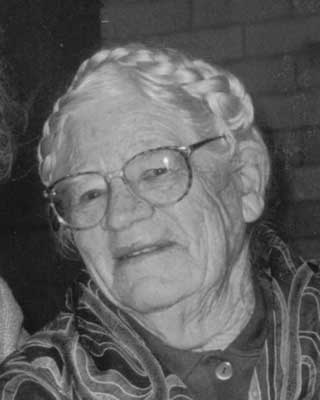
Activist for equality and peace, mentor and respected elder of Castlecrag, Life Member of the Castlecrag Progress Association
One of Castlecrag’s last links with its ‘early days’ was severed on 16 November 2006 with the death of Joyce Batterham. Just six months after joining with Joyce on the occasion of her 90th birthday (The Crag 160, p.2), a large number of her family, friends and colleagues came together again at the Community Centre on 24 November to ‘remember, celebrate and mourn’ her remarkable life.
Born at Rockdale on 16 May 1916, Joyce was the fifth of Absalom and Annie Deans’ six children. Both Absalom and Annie grew up in English families in which progressive Christian concern for the disadvantaged was a dominant theme. Absalom was ordained as a Congregational minister a month after their marriage and the young couple set out for the Western Australian goldfields as missionaries. Absalom was subsequently posted to Rockdale in Sydney, and then the family moved to Melbourne where they became associated with Walter and Marion Griffin. Joyce completed her schooling there, then went on to excel at Business College but was also strongly influenced by the values she gained from her parents. Her father, recognised as a leader in the community, preached tolerance and was greatly esteemed for his friendliness. Annie instilled in her daughter a recognition that women’s power rests in influence, not authority.
As reported in The Crag (160, p.2), Joyce came to Castlecrag in late 1931 to stay with her eldest brother Edgar, who had been appointed Secretary of the Greater Sydney Development Association, and his wife ‘Cappy’. She was soon enmeshed in the local community and was influenced by Walter and Marion Griffin and their colleagues. Later she returned to Sydney, where she met Bob Batterham and they were married in 1941.
During the War, Bob and Joyce became residents of Castlecrag, initially living with Rawson and Nancy Deans in the Fishwick House in The Citadel. Joyce and Bob became active members of the community and their four children – Robin, Tim, Dan and Lindy – grew up in the suburb. Joyce’s secretarial skills contributed significantly to community organizations in her suburb.
During the War, Castlecrag was a small suburb with four shops, an hourly bus service to the city, little street lighting, no medical services, no sanitary system and certainly no school. In 1944, Joyce joined with Frank Duncan to establish the Castlecrag & East Willoughby Community Advancement Co-operative Society Ltd to raise money for a community centre. Joyce was setting out on her lifelong involvement in Castlecrag community affairs. As secretary to the co-operative, she worked tirelessly mobilising people to run artists’ fairs, prepare afternoon teas and make Christmas toys to raise money for the project. It was therefore a proud moment for Joyce when her efforts became reality in November 1947 with the official opening of the Community Centre. Its function was expanded in 1951 with the opening of the Castlecrag Community Library. Joyce remained a tireless worker for the centre, serving as a volunteer at the library and as secretary for the Community Centre Management Committee into her eighties.
Joyce’s other great passion was lobbying for the establishment of the Castlecrag Infants’ School. The post-war boom had seen a rapid increase in the suburb’s population and Joyce and others efforts were rewarded with the official opening of the school on 30 June 1950. It was to become a centre for Infant education and community life for generations of Castlecrag families. Accordingly, when the government moved to close the school at the end of 1989 Joyce’s deep sense of social justice was aroused and, along with her daughter Lindy, played an important role for the next five years in the community’s fight to retain the school. Through the family’s union links ‘green bans’ were placed on the site (which opened the door for many other threatened school communities) preventing the Liberal Government from selling the site which they had rezoned to allow up to 64 townhouses to be built. Joyce was always waving a placard with her little granddaughters in the many demonstrations organised by the SOS*Crag group, their position vindicated today with overcrowding at surrounding public schools, and lots of young families living in the suburb.
The Castlecrag Progress Association recognised Joyce’s work by awarding her life membership. She was a regular at PA meetings until recent years, with a highlight being her special address at the Association’s 80th birthday dinner on 18 November 2005 (The Crag 158, p.3).
The many family, friends and colleagues at Joyce’s beloved Community Centre on 24 November heard moving presentations on these and other elements of a very full and productive life. Peter Watson, the former Archbishop of Melbourne, was an effective manager of proceedings. Margo Watson (nee Deans) spoke of the Deans parents and their influences on their children. Nancy Deans covered Joyce’s early years in Castlecrag, highlighting Joyce’s steadfast, courageous, loyal and brave character. Joyce’s daughter Lindy, through cousin Cathy, told of the family’s deep sense of respect and loss and concluded with a poem by the late Oogeroo Noonuccal (Kath Walker), a colleague of Joyce and Bob. Kim Batterham highlighted how she had been a point of reference in many people’s lives that was unchanging. Kate Westoby outlined Joyce’s many contributions to the Castlecrag community, while her longstanding friend, Jack Mundey, noted the link between the progressive Christian values of the Deans family and socialist ideals. He spoke of the wide range of people who loved and respected Joyce and noted how all those present had been enriched by her idealism and consistency. The selection of a Paul Robeson rendition of ‘Old Man River’ and music and song by Jeannie Lewis and Peter Winkler made strong contributions to the ‘Celebration of Joyce’s Life’.
The Editors
Enter your content.
